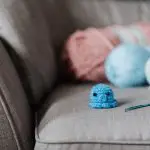As you consider the future of fabric starch innovations, think about how the demand for sustainability is reshaping the industry. You'll notice manufacturers are prioritizing eco-friendly formulations, utilizing biodegradable materials that align with consumer values. But it's not just about being green; smart starch technologies are on the horizon, promising to enhance fabric performance in ways we haven't seen before. What implications might these advancements hold for your laundry routine and the broader textile industry? The answers could redefine how we approach fabric care and sustainability.
Table of Contents
Key Takeaways
- Eco-friendly formulations using renewable materials will dominate the market, reducing environmental impact and appealing to eco-conscious consumers.
- Smart starch technologies will advance, offering temperature-sensitive and moisture-managing properties to enhance fabric performance and longevity.
- Biodegradable packaging solutions will become standard, minimizing waste and promoting sustainable practices in the textile industry.
- Innovations in multi-functional starches will provide added benefits like stain resistance and wrinkle elimination, simplifying laundry routines for consumers.
Overview of Fabric Starch History
Fabric starch has evolved significantly since its early use in ancient Egypt, where people first recognized its ability to stiffen and enhance the appearance of textiles. You might be surprised to learn that starch was initially derived from natural sources like rice and wheat. As time went on, cultures across the globe adopted starch for various purposes, including clothing, table linens, and even in religious ceremonies.
During the Middle Ages, starch gained popularity in Europe, especially among the aristocracy, who used it to create elaborate, starched collars and cuffs. You can see how starch became a symbol of status and refinement.
By the 19th century, the industrial revolution transformed starch production, making it more accessible and affordable. Factories began mass-producing starches, allowing the middle class to enjoy the benefits of this fabric treatment.
Today, you can appreciate the rich history of fabric starch, which has laid the groundwork for modern innovations. Understanding its journey from ancient Egypt to contemporary textiles can help you appreciate the versatility and practicality of fabric starch in your own life.
Current Trends in Fabric Starch
With a rich history behind it, today's fabric starch is embracing innovative formulations and applications that cater to modern consumer needs.
You'll notice a shift toward convenience, with spray starches becoming increasingly popular. These products allow for quick touch-ups, making your laundry routine more efficient.
Moreover, manufacturers are focusing on performance enhancements. Many starches now offer wrinkle resistance and longer-lasting crispness, ensuring your clothes maintain a polished appearance throughout the day. You might also find starches infused with scents, adding a fresh aroma to your fabrics.
Another trend is the rise of multi-functional starches that not only provide stiffness but also offer benefits like stain resistance or fabric protection. This means you can simplify your laundry regimen while enjoying added features.
Eco-Friendly Starch Formulations
When you're considering fabric starch, think about the impact of your choices on the environment.
Sustainable sourcing practices and biodegradable starch options are becoming essential for eco-conscious consumers like you.
Embracing these innovations not only helps the planet but can also enhance your laundry routine.
Sustainable Sourcing Practices
How can eco-friendly starch formulations transform the textile industry while promoting sustainable sourcing practices?
By incorporating renewable materials derived from plants, you can significantly reduce the environmental impact of fabric starch production. These formulations not only minimize reliance on petrochemicals but also encourage the growth of sustainable agricultural practices. When you choose starches sourced from responsible farms, you're supporting ecosystems, biodiversity, and the livelihoods of farmers.
In addition, eco-friendly starch formulations often prioritize local sourcing, which cuts down transportation emissions and supports regional economies. By opting for biodegradable and non-toxic ingredients, you ensure safer conditions for workers and consumers alike. This shift towards sustainability can enhance your brand's reputation, appealing to increasingly eco-conscious consumers.
Moreover, implementing sustainable sourcing practices means you're likely to foster innovation in your supply chain. As you partner with suppliers committed to eco-friendly practices, you can explore new formulations and applications that meet both performance and sustainability goals.
In this way, you're not just transforming your products; you're contributing to a broader movement towards a more responsible textile industry. Embrace eco-friendly starch formulations today and lead the change for a greener tomorrow.
Biodegradable Starch Options
Biodegradable starch options offer a sustainable alternative for fabric finishing, effectively combining performance with environmental responsibility. You'll find these eco-friendly formulations derived from natural sources like corn, potatoes, or tapioca, making them safe for both you and the planet.
When you choose biodegradable starch, you're not just enhancing the look and feel of your fabrics; you're also reducing your environmental footprint. These starches break down naturally, unlike traditional chemical-based finishes, which can linger in landfills for years.
They perform exceptionally well, providing the stiffness and crispness you desire in your garments without sacrificing quality. As you explore these options, you'll notice that they often require less energy during application and can be used in smaller quantities, further minimizing waste.
Incorporating biodegradable starch into your fabric care routine is a step towards a greener future. It aligns with the growing demand for sustainable practices in the textile industry.
Smart Starch Technologies
Smart starch technologies are revolutionizing the way fabrics maintain their shape and appearance, making ironing and upkeep easier than ever.
These innovative solutions harness advanced formulations that respond to temperature and humidity, ensuring your garments look pristine without the hassle of traditional starch.
Here are four exciting benefits of smart starch technologies:
- Temperature Sensitivity: These starches activate at specific temperatures, providing optimal stiffness when needed and allowing for flexibility in casual settings.
- Moisture Management: Advanced formulations repel water, preventing stains and enhancing the longevity of your fabrics while keeping them fresh.
- Eco-Friendly Options: Many smart starch technologies are designed with sustainability in mind, using biodegradable components that reduce environmental impact.
- Easy Application: You can spray or wash these starches on, making them accessible for home use or in professional laundry services.
With smart starch technologies, you gain convenience and elevate your fabric care game.
Whether you're tackling dress shirts or table linens, these innovations promise to keep your textiles looking sharp and stylish with minimal effort.
Impact on Fabric Performance
The impact of innovative starch technologies on fabric performance is profound, enhancing durability and maintaining a polished appearance even after multiple washes.
When you use advanced starch products, you'll notice that your fabrics resist wrinkles and creases more effectively, allowing you to enjoy a crisp look throughout the day. This means less time spent ironing, giving you more freedom to focus on what truly matters.
Moreover, these innovations help fabrics withstand wear and tear, extending their lifespan significantly. You'll find that garments treated with modern starches can endure frequent use without losing their shape or integrity. This durability translates into better value for your investment in clothing.
Additionally, with improved stain resistance, you can tackle spills and dirt with confidence, knowing your fabrics are better protected. This feature not only keeps your clothes looking fresh but also reduces the need for frequent washing, which can wear down fabrics over time.
Ultimately, you'll appreciate how innovative starch technologies elevate your fabric experience, combining functionality with a polished aesthetic. As these advancements continue to evolve, you can expect even greater enhancements in fabric performance that cater to your everyday needs.
Sustainability in Textile Care
When you think about textile care, consider eco-friendly starch options that not only keep your fabrics looking fresh but also minimize environmental impact.
You'll find biodegradable packaging solutions that enhance sustainability while making your life easier.
It's time to rethink how we care for our textiles and embrace greener choices.
Eco-Friendly Starch Options
Eco-friendly starch options offer a sustainable way to maintain the crispness of your fabrics while minimizing environmental impact.
By choosing these alternatives, you contribute to a healthier planet without sacrificing the quality of your textile care.
Here are four eco-friendly starch options to consider:
- Cornstarch: A natural and biodegradable option, cornstarch provides excellent stiffness and is safe for most fabrics. It's easy to make at home, reducing packaging waste.
- Potato Starch: Known for its superior finish, potato starch is another renewable resource. It's also effective in eliminating wrinkles and can be found in various eco-friendly brands.
- Rice Starch: This gentle starch is perfect for delicate fabrics. It's derived from rice, making it an excellent option for those seeking plant-based solutions.
- Wheat Starch: Often used in traditional textile care, wheat starch is biodegradable and derived from a renewable resource. It works well for both crisp finishes and softer drapes.
Biodegradable Packaging Solutions
Biodegradable packaging solutions play a crucial role in promoting sustainability in textile care by reducing waste and minimizing environmental impact. When you opt for biodegradable materials, you're choosing options that break down naturally, reducing the burden on landfills and oceans. This is especially important in the textile industry, where packaging waste can accumulate quickly.
You'll find numerous biodegradable alternatives available today, from plant-based films to recycled paper. These materials not only serve their purpose effectively but also align with growing consumer demand for eco-friendly practices. By switching to biodegradable packaging, you're sending a message that you care about the environment and are willing to invest in sustainable solutions.
Moreover, using biodegradable packaging can enhance your brand's reputation. Consumers are increasingly looking for brands that prioritize sustainability, and by adopting these practices, you can attract a more environmentally conscious audience.
Incorporating biodegradable packaging into your textile care routine isn't just a trend; it's a necessary step toward a more sustainable future. So, make the switch today and contribute to a healthier planet while providing your customers with the quality they expect.
Future Challenges and Opportunities
As the fabric starch industry evolves, you'll encounter both challenges and exciting opportunities that demand innovative solutions. The landscape is shifting, and staying ahead requires you to adapt quickly. Here are four key areas where you can focus your efforts:
Sustainability: Embrace eco-friendly materials to reduce environmental impact. Consumers are increasingly seeking sustainable options, and you can lead this charge.
Technological Advancements: Invest in R&D to explore new formulations and applications. Innovations like nanotechnology can enhance starch properties, making them more versatile.
Market Diversification: Expand your product line to cater to various industries, including textiles, packaging, and even food. This diversification can help mitigate risks and tap into new revenue streams.
Consumer Education: Engage with your customers to raise awareness about the benefits of fabric starch products. Informed consumers are more likely to choose your brand over competitors.
Frequently Asked Questions
How Does Fabric Starch Affect the Longevity of Clothing?
Fabric starch can enhance your clothing's longevity by providing a protective layer against dirt and wear. It helps maintain crispness and shape, reducing the frequency of washes and extending the life of your garments.
Can Fabric Starch Be Used on All Types of Fabrics?
You can't use fabric starch on all types of fabrics. It's great for cotton and linen, but it might damage delicate materials like silk or wool. Always check the care label before applying starch.
What Safety Precautions Should Be Taken When Using Fabric Starch?
When using fabric starch, you should work in a well-ventilated area, wear gloves to protect your skin, and avoid inhaling the spray. Always read the product label for specific safety instructions and recommendations.
Are There Natural Alternatives to Traditional Fabric Starch?
Yes, there are natural alternatives to traditional fabric starch. You can use cornstarch mixed with water, rice water, or even homemade potato starch. These options provide a gentle, eco-friendly way to stiffen your fabrics.
How Do Different Starch Formulations Impact Ironing Efficiency?
Different starch formulations can significantly impact ironing efficiency. You'll notice that some provide a smoother finish, while others might leave fabric stiff. Experimenting with various types helps you find the perfect balance for your needs.
- How Does Ring Spun Cotton Affect Garment Fit and Shape Retention? - August 13, 2024
- What Are the Challenges in Producing Ring Spun Cotton? - August 13, 2024
- Is Ring Spun Cotton Suitable for Plus-Size Clothing? - August 13, 2024






